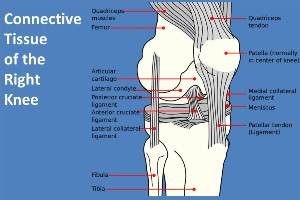 Connective tissue is one of the four basic tissue types that comprise the human body. The other three types are epilethial tissue (skin and internal lining), nervous tissue and muscle tissue.
Connective tissue is one of the four basic tissue types that comprise the human body. The other three types are epilethial tissue (skin and internal lining), nervous tissue and muscle tissue.
As the name suggests, the purpose of connective tissue is to connect and support other parts of the body. Certain types, such as adipose (fatty) tissue are also used to store energy. Connective tissue is both more fibrous and diverse than other tissue types, ranging in consistency from a gel-like structure to being hard like bones.
Unlike most other kinds of cells, which are directly attached to each other, individual cells of connective tissue are scattered throughout an extracellular matrix of what is called ground substance. Ground substance is a clear viscous fluid that fixes water and collagen fibers so they are held together in the extracellular space. The matrix is produced by fibroblast cells and is comprised of three kinds of fibers that work together to support the cells and provide strength: collagen, elastic fibers and reticular fibers. Collagen alone comprises more than a quarter of the total protein in the body.
Connective tissue is subdivided into three subtypes:
- Embryonic connective tissue. As the name suggests, embryonic connective tissue is formed in the embryo, and this is the tissue from which all other connective tissue arises.
- Proper (or mature) connective tissue. Proper connective tissue can be referred to as either “loose’ or “dense” depending on its structure.
Areolar and adipose tissue are both examples of loose connective tissue. Together they form the subcutaneous layer of the skin that attaches our skin to the tissues and organs underneath and which also insulates the body against changes in temperature. Reticular connective tissue is also classified as loose and consists of interweaving reticular fibers. Reticular connective tissue provides support and structure in the spleen, liver and lymph nodes.
Dense connective tissue can be regular, irregular or elastic. Regular dense connective tissue consists of neatly arranged bundles of collagen fibers, which provide this tissue with the great strength that is needed in our ligaments and tendons. Irregular dense connective tissue is also strong, but in all directions rather than just one. It is found in the dermis of the skin and pericardium (the supportive sac which encloses the heart). Elastic connective tissue is dominated by elastin fibers and is found in the parts of the body that need tissue with an ability to stretch, such as the lungs and arteries.
- Special connective tissue (including cartilage, blood, hemapoetic (blood-producing) tissue, bone and lymphatic tissue).
Cartilage and bone are special connective tissues that provide more solid structure to parts of the body. Bone is harder and tougher than cartilage, but both can resist a considerable amount of stress.
Lymphatic tissue and blood are the fluid types of special connective tissue. The function of blood in transporting oxygen and carbon dioxide to cells is well known. Lymphatic fluid has a role in draining excess fluid from the body, supporting the immune response and aiding in the transport of certain dietary fats and fat-soluble nutrients.

